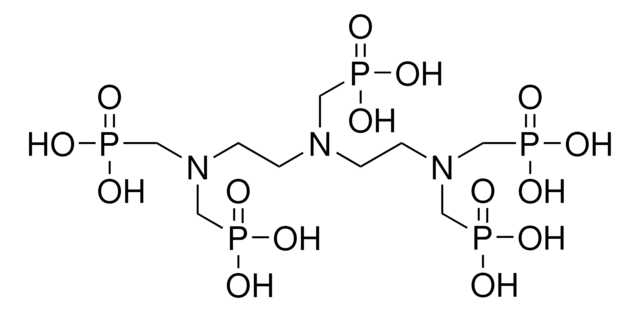15149
N,N-Bis(phosphonomethyl)glycine
≥98.0% (T)
Synonym(s):
N-(Carboxymethyl)iminodi(methylphosphinic acid), Glyphosine
About This Item
Recommended Products
Assay
≥98.0% (T)
functional group
amine
SMILES string
O=P(CN(CP(O)(O)=O)CC(O)=O)(O)O
InChI
1S/C4H11NO8P2/c6-4(7)1-5(2-14(8,9)10)3-15(11,12)13/h1-3H2,(H,6,7)(H2,8,9,10)(H2,11,12,13)
InChI key
OXHDYFKENBXUEM-UHFFFAOYSA-N
General description
Application
Anti-diabetic; delay onset of diabetes in non-obese NOD mice
Glyphosine binds to a pocket of MHC class II molecules I-Ag7 and DQ8, and modify T cell responses to the autoantigenic insulin B chain fragment 9–23 (B:9–23) peptide. Glyphosine stimulate IL-10 production and delay onset of diabetes in non-obese NOD mice.†
Biochem/physiol Actions
Signal Word
Danger
Hazard Statements
Precautionary Statements
Hazard Classifications
Eye Dam. 1
Storage Class Code
8A - Combustible corrosive hazardous materials
WGK
WGK 1
Flash Point(F)
Not applicable
Flash Point(C)
Not applicable
Personal Protective Equipment
Regulatory Listings
Regulatory Listings are mainly provided for chemical products. Only limited information can be provided here for non-chemical products. No entry means none of the components are listed. It is the user’s obligation to ensure the safe and legal use of the product.
JAN Code
15149-VAR:
15149-BULK:
15149-10G:
15149-50G:
Choose from one of the most recent versions:
Already Own This Product?
Find documentation for the products that you have recently purchased in the Document Library.
Customers Also Viewed
Our team of scientists has experience in all areas of research including Life Science, Material Science, Chemical Synthesis, Chromatography, Analytical and many others.
Contact Technical Service









